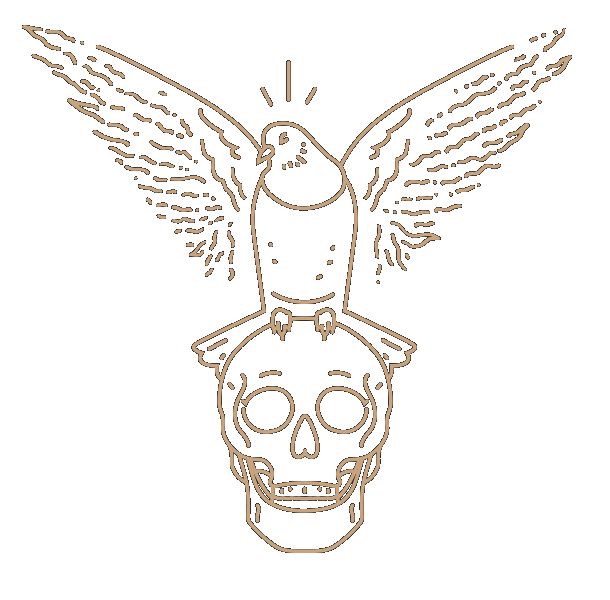
It was another week at the office, and like most weeks, another student dropped off a portfolio to be considered for an internship. After our young applicant left, we dropped the black leather bound case on the pool table and unzipped it to see what lay inside. The situation was all too familiar, however the work that lay in front of us was not.
This was the first portfolio we've seen that didn't actually have any graphic design in it – No typography, layout, composition, or anything that a designer would be judged on when applying for a design job. What sat in place was a selection of well composed photographs and fine art abstract illustrations. Our applicant wasn't a designer at all, but a traditional artist looking to make the jump into the world of commercial design. Without any preconception or fear of the industry, she came in and put her work at our mercy hoping for the best…
At first I was bewildered as to why someone would do this, but after taking a step back, I really began to think about my early days of romancing design. I admired our applicants ambition and hopefulness, remembering what it was like to be a self-starter without any guidance at the begining. Seeing someone dive headlong into design without any preconceived ideas of what they were doing was admittedly refreshing. While taking someone on as an intern with no experience would not be viable in our intimate, fast-paced setting, I did take the time to talk with her about what she wants to do and (hopefully) provide a good starting point for self-education.
The following are the essential topics that fledgling designers must begin wrapping their heads around. Each point is accompanied by a short-list of the best literature out there for anyone looking to make the transition into design:
Build your house on a strong foundation
Familiarizing yourself with the basics of design is essential. There are many basic design books out there that cover the nitty-gritty topics of color theory, balance, proximity, alignment, repetition, etc. If you're already a creative person, much of this may be familiar territory, but design is as much about logic as it is creativity (if not more so). Learning to put your creative instinct to tangible words, rules and practices is essential for the success of young designers.
Read:
The Non Designer's Design Book
Graphic Design: The New Basics
Making and Breaking the Grid
<3 Typography
Of all the compositional elements you'll work with in design, type is the hardest to master (and one of the most important). From the anatomy of an individual letter to complex page layout grid systems, there is a staggering amount of technical knowledge and technique to learn. The nuances of type design will seem insignificant and detail oriented at first, but this is an area where the more you learn the less you realize you actually know. If you build a thorough understanding of type, you will fast track your chances for success. Design shops look for good type above all else for internship positions and entry level hires.
Read:
Thinking With Type
The Elements of Typographic Style
Stop Stealing Sheep and Find Out How Type Works
Get a History Lesson
Outside of basic design theory and type, begin building a top-level understanding of design history and how it has affected modern cultures of past and present. Trends come and go, but history tends to repeat itself. Having a general idea of period design over the last 100+ years will not only help you understand how modern design came to be, but will also help you make informed decisions for your own work.
Read:
Graphic Design Referenced
Megg's History of Graphic Design
Tools of the Trade
If you haven't already, get yourself a copy of the Adobe Creative Suite, Photshop, Illustrator and Indesign specifically. These three tools are essential for most designers, and can take some time to understand. Learning design software is like learning to draw or paint – it takes a good while to learn the ins and outs of the applications. Even after 10+ years of using the tools, I still find new shortcuts, techniques and ways to make the job easier through my "tools". Depending on which areas of design interest you the most, familiarize yourself with how design applies to the mediums you intend to learn. For instance, if interested in print, learn about pre-press, mechanical file building, color separation, and the various kinds of printing techniques out there.
Acquire:
Adobe Creative Suite
Get in the mindset
Design is a professional service and not personal artistry. You have to be passionate about it, but also able to remove yourself from becoming emotionally over-invested in your work. Where art is a self-serving form of personal expression, design is a business service that has many moving parts and outside influences that will inform the final product. Clients, budgets, bosses, timelines, teams, production limitations and more can all contribute to the ruin of a personal vision. Too many hopeful designers get beat down by this when they enter the career fresh out of school. By embracing design as a professional service from the start and making an effort to understand it’s value from a business perspective, you will stand a better chance at not burning out or falling out-of-love with the it.
Read:
How to be a Graphic Designer Without Losing Your Soul
Make Stuff
Most importantly, find any and all reasons to begin practicing – Get inspired and start making stuff! Don't be afraid to pull inspiration from existing sources and use other people's work to better your own practice. In essence, copy the good design you see, as this will help you understand what goes into making good design (note: copy, not steal). Young designers get overly hung up on originality, and it can really hinder them from building a creative muscle memory.
